Efficient scheduling is critical for small businesses, especially when budgets are tight. Free scheduling tools can save time, reduce errors, and improve customer satisfaction without adding financial strain. Here's a quick rundown of the best options:
- Calendly: Simple to use, with features like unlimited event scheduling, calendar syncing, and automated notifications.
- Picktime: Basic yet effective for managing appointments across multiple locations.
- HubSpot Meeting Tool: Ideal for sales teams, integrating scheduling with CRM for better client management.
- Setmore: Supports up to four users, integrates with social platforms, and is great for service-based businesses like salons or gyms.
- Connecteam: Combines scheduling with workforce management, perfect for field teams and shift-based businesses.
Each tool offers unique features tailored to different business needs, from online booking to team scheduling. To choose the right one, consider your team size, industry, and integration needs. Below is a quick comparison of their features:
Quick Comparison
| Tool | Best For | Key Features | Free Plan Limitations |
|---|---|---|---|
| Calendly | Professionals needing quick setup | Unlimited scheduling, calendar syncing | Limited to one calendar connection |
| Picktime | Multi-location businesses | Multi-location support, simple interface | Limited advanced features |
| HubSpot | Sales-focused teams | CRM integration, group scheduling | One personal meeting link |
| Setmore | Service-based small businesses | Social media integration, group bookings | Supports up to four users |
| Connecteam | Deskless/field teams | Shift management, mobile app, time tracking | Free for up to 10 users |
Key takeaway: Free tools are a practical solution for small businesses to streamline scheduling and improve operations without extra costs. Choose one that aligns with your specific needs, and make the most of its free features to boost efficiency.
The Ultimate Free Appointment Scheduling Tools For Small Businesses
Top Free Scheduling Tools for Small Businesses
Finding the right scheduling tool can make a world of difference in how your small business manages appointments and meetings. Each platform brings its own strengths to the table, catering to a variety of business needs. Here’s a rundown of some top free scheduling tools designed to help small businesses stay organized and efficient.
Calendly
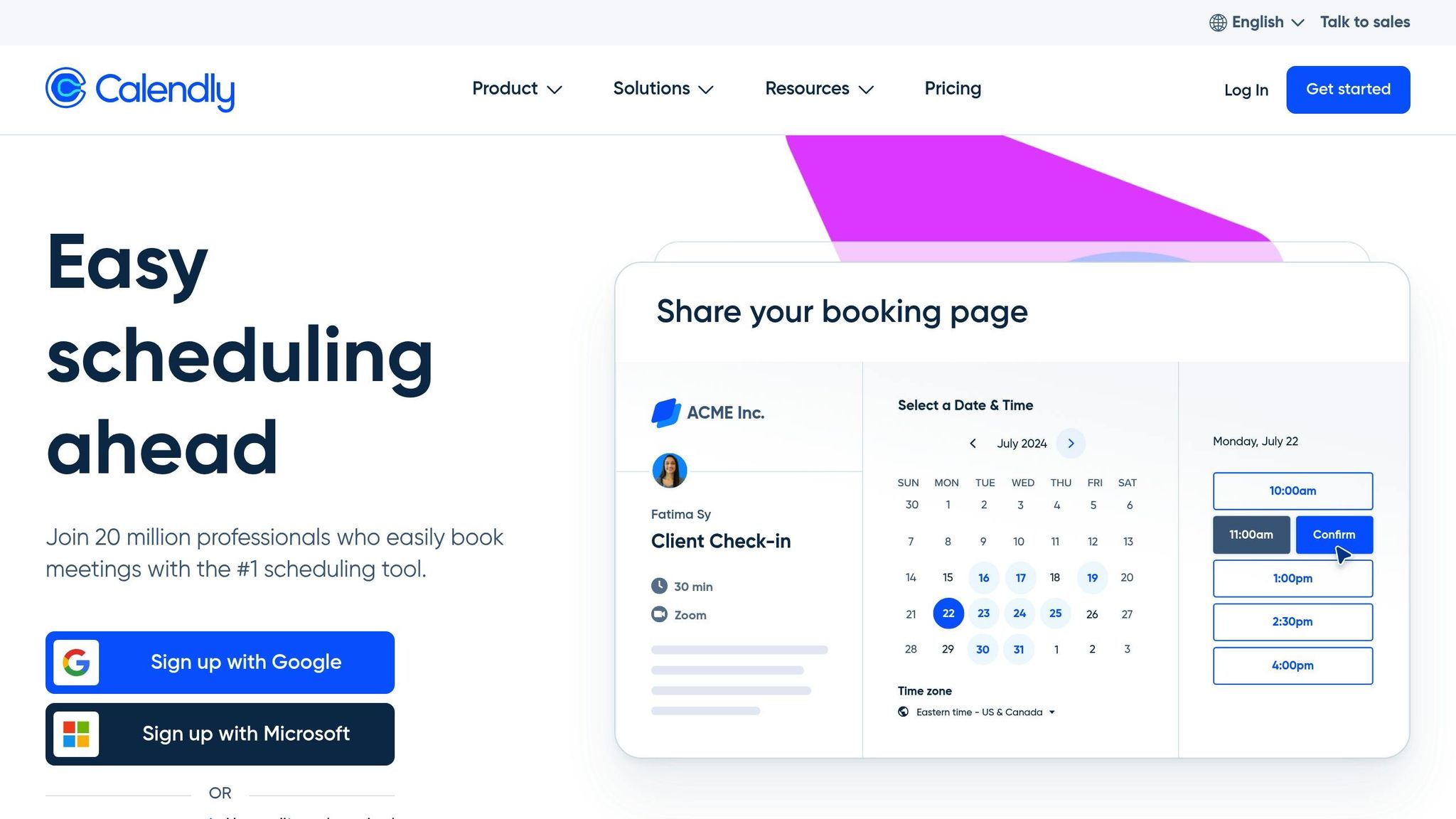
Calendly has earned its reputation as a go-to scheduling tool, thanks to its simple setup and intuitive design. Even first-time users can get started in under five minutes. The free plan includes one connected calendar, unlimited event scheduling, Meeting Polls, and automated notifications for upcoming events. Alek Relyea, Senior Manager of Technical Engagements at HackerOne, highlights its efficiency:
"Calendly works. It's got a great UI, great support, and no complaints from our compliance team. If your organization is spending a lot of time going back and forth just to get on a call, it's a no-brainer."
This tool is versatile and works seamlessly for businesses in sales, marketing, customer service, recruiting, HR, and IT support.
Picktime
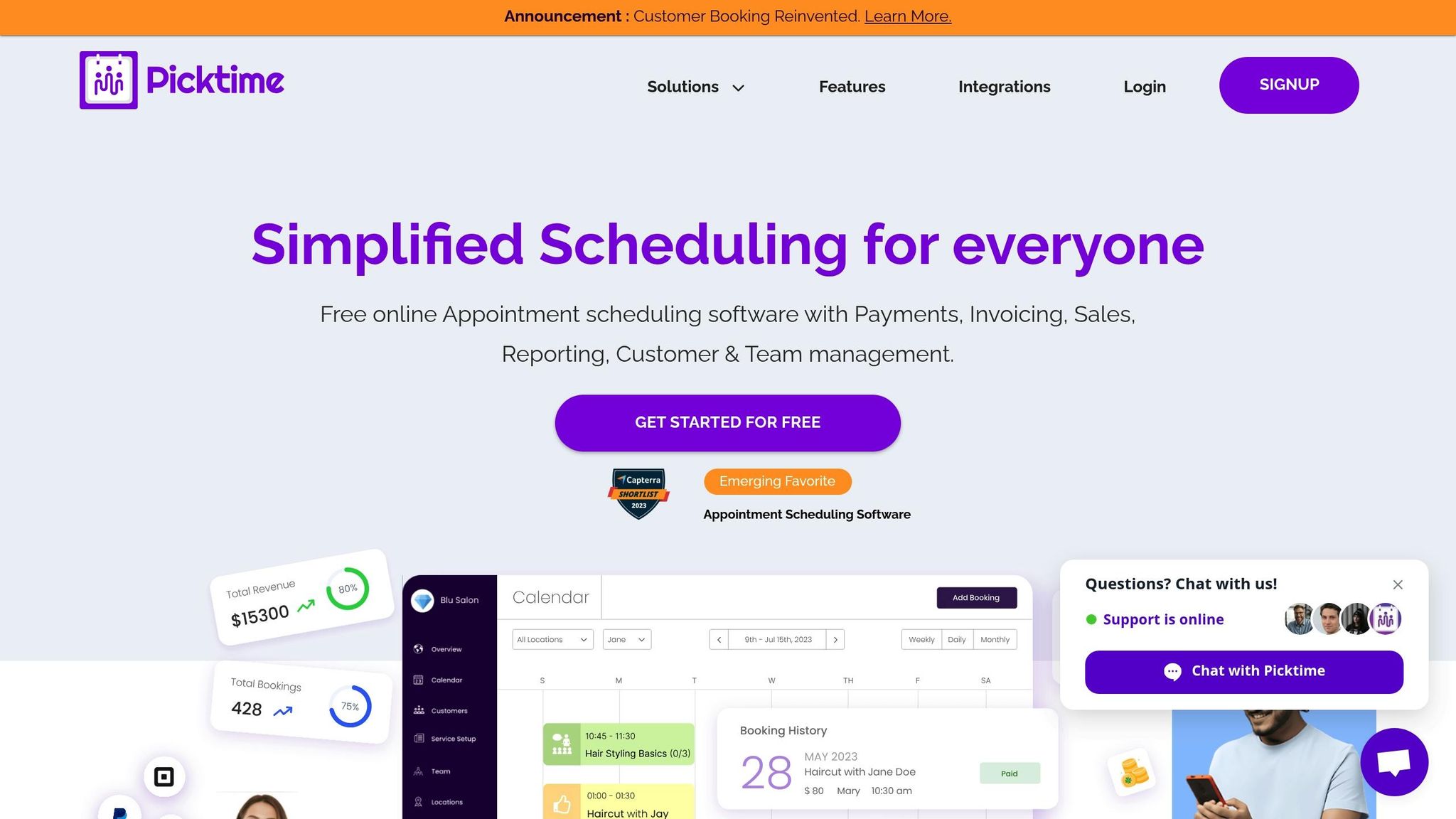
Picktime focuses on delivering essential scheduling features tailored to the needs of small businesses. While it keeps things simple, it provides the core functionality needed for effective appointment management.
HubSpot Meeting Tool
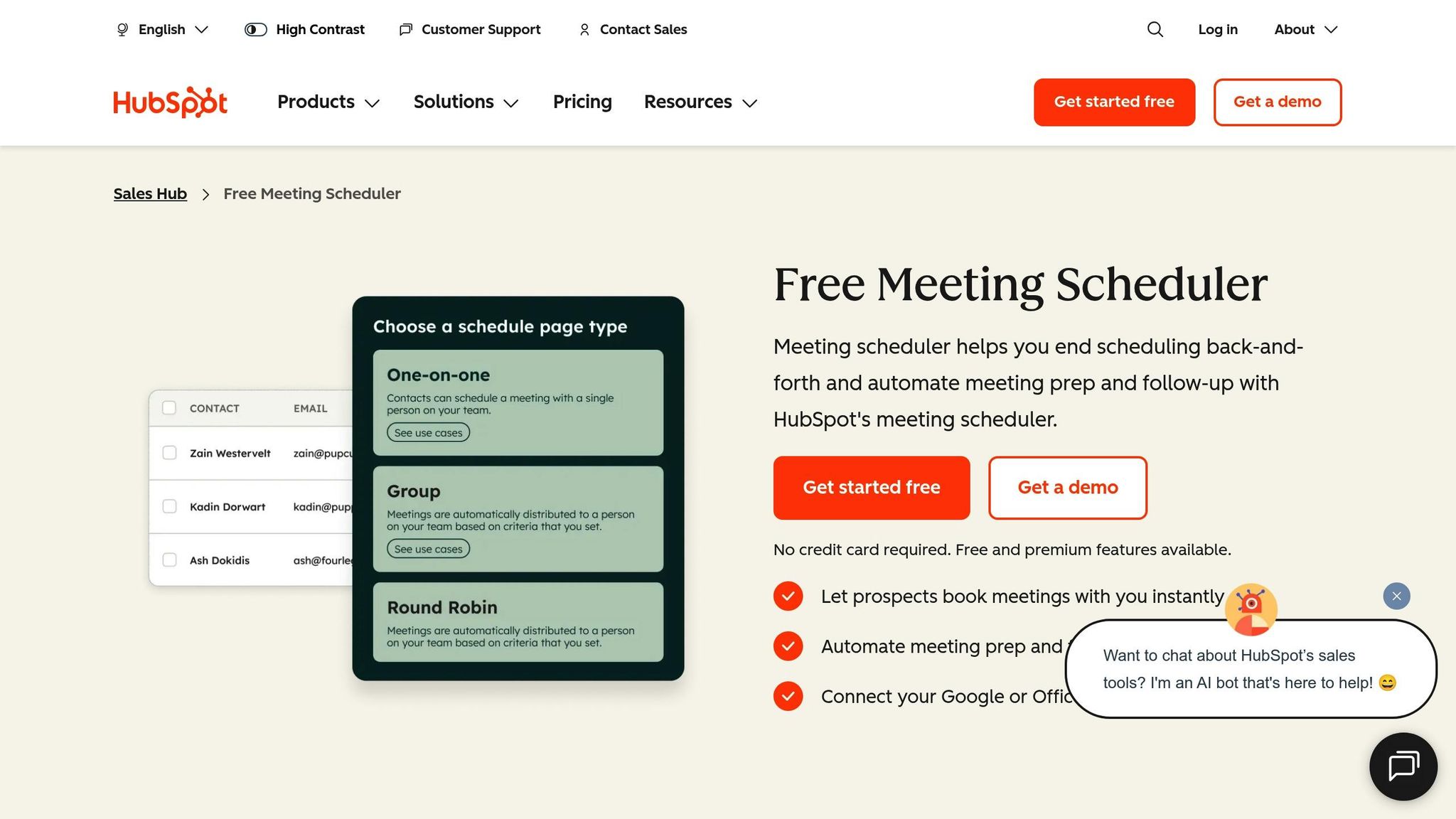
HubSpot’s free meeting scheduler goes beyond basic appointment booking. It’s especially useful for businesses that want to integrate scheduling with their sales workflows. The tool automatically adds prospects to the HubSpot contact database, helping sales teams stay organized and follow up more effectively. With real-time calendar syncing and options for group or round-robin scheduling, it eliminates the back-and-forth of email coordination. The free plan includes one personal meeting link, making it a great fit for sales-focused teams.
As Scott Weiss explains:
"I like that the HubSpot Meetings Tool is easy to use. Its Calendar Integration syncs real-time with Google Calendar and Office 365. It also sets your availability, and has prospects and customers book time with you."
Setmore
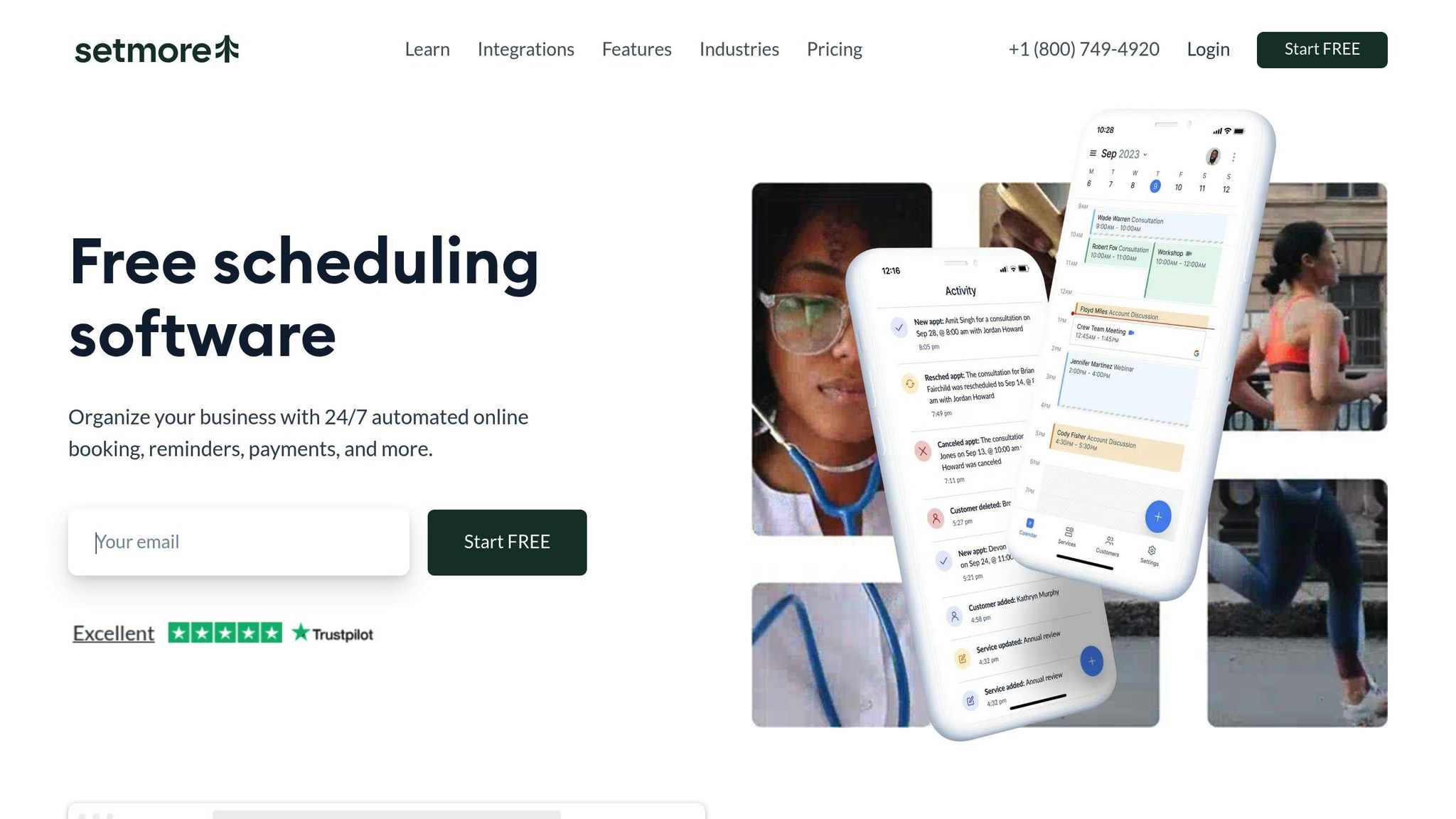
Setmore is designed with simplicity in mind, making it a great choice for individual service providers and small service-based businesses. The free plan supports up to four users and includes unlimited appointments, calendar syncing with Google Calendar and Office 365, and customizable SMS and email reminders. It also integrates with social media platforms, video conferencing tools, and payment systems.
This tool is particularly well-suited for barbershops, personal trainers, salons, and healthcare providers, offering flexibility for one-on-one appointments, recurring bookings, and even group classes.
Connecteam
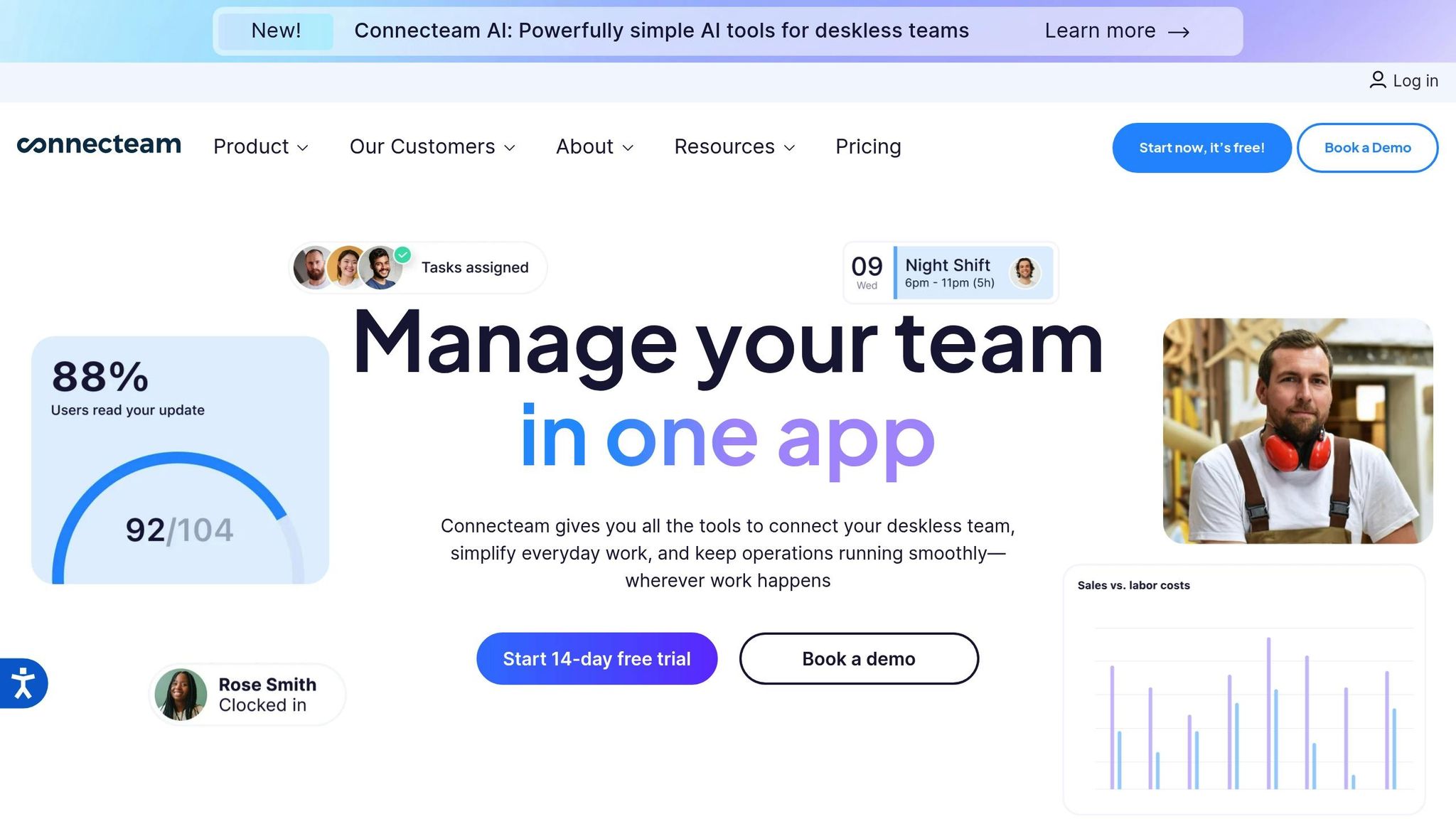
Connecteam takes scheduling a step further by combining it with employee management features. It’s perfect for deskless teams and businesses that need to manage shifts across multiple locations. The free plan supports teams of up to 10 employees and includes tools for shift management, time tracking, and task management - all accessible through a mobile-friendly platform. This makes it easy to create schedules, share them, and handle last-minute changes on the go.
Feature Comparison
Finding the right scheduling tool for your business can be a game-changer. Among the options, Connecteam stands out with its comprehensive free plan, offering more than just basic scheduling - it includes features tailored for employee management.
Feature Comparison Table
| Feature | Calendly | Picktime | HubSpot Meeting Tool | Setmore | Connecteam |
|---|---|---|---|---|---|
| User Limit | Not specified | Not specified | Not specified | Not specified | Up to 10 users |
| Calendar Connections | Not specified | Not specified | Not specified | Not specified | Single schedule |
| Appointment/Job Scheduling | Not specified | Not specified | Not specified | Not specified | Job scheduling available |
| Mobile App | Not specified | Not specified | Not specified | Not specified | Robust mobile app for deskless teams |
| Notifications/Updates | Not specified | Not specified | Not specified | Not specified | Chat and updates available |
| Time Zone Support | Not specified | Not specified | Not specified | Not specified | Not specified |
| Integration Options | Not specified | Not specified | Not specified | Not specified | All-in-one employee management solution |
| Group Scheduling | Not specified | Not specified | Not specified | Not specified | Employee scheduling |
| Customization | Not specified | Not specified | Not specified | Not specified | Up to 5 custom recognition badges, 3 automated reports, and 12 help desks |
| Storage/Data Limits | Not specified | Not specified | Not specified | Not specified | 500MB knowledge base |
| Advanced Features | Not specified | Not specified | Not specified | Not specified | Includes features like a single time clock and job scheduling; lacks offline time tracking and mileage tracking |
This table highlights the features of each tool, with a detailed look at Connecteam's offerings.
Summary
Connecteam's free plan is especially appealing for small businesses, offering tools that go beyond simple scheduling. It supports up to 10 users, includes a mobile app designed for deskless teams, and allows for meaningful customization like automated reports and recognition badges. However, there are limitations: the free plan is restricted to one time clock and schedule, and it lacks offline and mileage tracking capabilities.
For Calendly, Picktime, HubSpot Meeting Tool, and Setmore, specific details about their free plans were unavailable from current sources. To ensure you're making the best choice, visit their official websites for the latest updates and plan features.
sbb-itb-d1a6c90
How to Pick the Right Scheduling Tool for Your Business
Free scheduling tools can be a game-changer for small businesses, helping them stay organized and grow without breaking the bank. The key to success lies in choosing a tool that aligns with your team size, industry, and daily operations. Pick the wrong one, and you might find yourself dealing with unnecessary inefficiencies. Pick the right one, and it can simplify your workflow in ways you didn’t think possible.
What to Consider When Choosing
Start by thinking about your team size. Smaller teams can often make do with free plans that cover the basics, but larger teams might need tools that can grow with them. Your industry also plays a big role. For example, a salon or a consulting firm will likely need features like client-facing booking pages, while a retail business might prioritize tools that focus on managing employee schedules.
Integration is another factor you can’t overlook. If you already use tools like CRM software, email marketing platforms, or accounting programs, make sure your scheduling tool works seamlessly with them. Mobile accessibility is crucial if your team works remotely or in the field - many tools now offer apps designed for quick and easy scheduling on the go.
Customization is equally important. Some businesses might need branded booking pages to maintain a professional image, while others may only require basic functionality like custom fields or automated reminders. By identifying your specific needs, you can narrow down your options and find a tool that fits like a glove.
When Each Tool Works Best
Different tools shine in different scenarios, so it’s worth matching their strengths to your business needs:
- Calendly is perfect for professionals like consultants and sales teams who need a reliable tool for booking external meetings.
- Picktime works well for service-based businesses with multiple staff, such as salons or medical practices.
- HubSpot Meeting Tool is a natural fit for those already using HubSpot’s ecosystem, especially marketing agencies.
- Setmore strikes a balance between client and internal scheduling, making it a great choice for restaurants and spas.
- Connecteam caters to hourly or field teams in industries like construction, cleaning services, and retail, offering task assignments alongside scheduling.
If your business revolves around appointments, you’ll want a system that prioritizes client-facing booking. On the other hand, shift-based operations often benefit from tools that include employee scheduling and time tracking. And don’t forget to think long-term - choosing a platform that can grow with your business will save you the headache of switching systems down the line. By aligning your choice with your specific needs, you can streamline your scheduling process and keep your business running smoothly.
Setting Up Your Free Scheduling Tool
Getting your scheduling tool set up correctly right from the start can save you headaches down the road. A well-configured system encourages your team to embrace the tool and avoid falling back into inefficient practices. Taking a little extra time now to get it right can make a big difference later.
Setup Best Practices
The first step? Integrate your calendar. Most scheduling tools sync with platforms like Google Calendar, Outlook, or Apple Calendar. Double-check that appointments sync properly and that time zones are set up correctly. Test a few sample bookings to confirm everything works smoothly.
Next, customize your booking pages to reflect your brand. Add your logo, choose colors that match your business, and write clear descriptions of your services. Replace generic labels like "30-minute meeting" with specific titles such as "Initial Consultation" or "Project Planning Session." Include a brief description so clients know exactly what to expect.
Don’t forget to set up buffer times between appointments. A 15-minute gap can give you just enough breathing room to finish notes, grab a coffee, or prep for the next meeting. It’s a small tweak that can make busy days feel much more manageable.
Configure notifications to keep everyone on the same page. Most tools let you send automatic reminders to clients and staff, often 24 hours and 1 hour before the appointment. Make sure these notifications include all the key details to reduce no-shows and confusion.
Once the technical pieces are in place, focus on getting your team comfortable with the tool.
Training Staff and Getting Everyone On Board
Introducing a new scheduling tool to your team requires more than just a quick demo - it’s about making sure everyone feels confident using it. Start by showing how it works in a team meeting. Walk through the basics like booking, rescheduling, and canceling appointments, as well as handling common scenarios.
Create a simple guide for reference. Keep it short - one or two pages with screenshots of the most common tasks. Skip the lengthy manuals; focus on day-to-day actions like checking schedules, adding appointments, or updating client details.
Give your team hands-on practice. Let them simulate booking and rescheduling appointments to uncover any confusion before it impacts real clients. Address questions on the spot and update your guide with any new tips or clarifications.
Appoint a go-to person for questions. This team member should take the time to master the tool’s advanced features and troubleshoot common problems. Having an expert on hand can prevent small issues from escalating into bigger frustrations.
For larger teams, consider a phased rollout. Start with a few early adopters who can help guide others as they get familiar with the system.
With everyone on board, you can make the most of your scheduling tool - even within the limits of a free plan.
Making the Most of Free Plan Limits
Free plans often come with restrictions, but a little creativity can help you work around them. For example, many tools limit the number of users, typically allowing 1–3 accounts. If you need more access, consider having key team members share login credentials for basic scheduling tasks, while reserving individual accounts for those who need more advanced features.
Feature limitations can also be a hurdle. Some tools reserve certain capabilities, like automated follow-ups, for paid plans. But you can often use integrations to fill the gaps. For instance, connect your scheduling tool to a free email marketing service to send follow-ups manually or semi-automatically.
Data storage limits might mean your appointment history isn’t saved indefinitely. To avoid losing important client information, export your data monthly and save it in a spreadsheet or sync it with your existing customer management system. This backup ensures you’re covered if you ever switch tools.
While free plans often include branding restrictions - like displaying the tool’s logo instead of your own - you can maintain a professional look by embedding the booking page into your website. Create a dedicated page that links to the scheduling tool, so clients see your branding first.
Finally, if your business needs outgrow a single free account, consider using multiple accounts strategically. This can help you expand capacity without upgrading to a paid plan, giving you more flexibility while keeping costs down.
Conclusion: Better Scheduling for Small Business Growth
An effective scheduling tool can simplify appointment management, save time, and enhance customer satisfaction. Free scheduling tools give small businesses the ability to provide professional booking experiences without incurring high costs, helping them compete in a crowded market.
Here’s a quick recap of what each tool brings to the table:
Main Points Summary
- Calendly: Offers straightforward booking with smooth calendar integration and automated reminders, making it a reliable choice for hassle-free scheduling.
- Picktime: Supports unlimited bookings and multiple locations, making it ideal for businesses managing complex schedules or growing teams.
- HubSpot Meeting Tool: Stands out with integration options and built-in CRM features, allowing businesses to manage client relationships alongside scheduling.
- Setmore: Combines ease of use with features like class scheduling and customer management, catering to both individual and group appointments.
- Connecteam: Merges workforce management with appointment booking, perfect for field service businesses juggling staff schedules and client appointments.
To make the most of these tools, focus on using the free plan limits effectively. This might involve strategic account sharing or exporting data regularly to stay organized.
These tools highlight how efficient scheduling can drive small business growth. When clients can book appointments easily, and staff can dedicate more time to delivering quality service instead of managing admin tasks, scalability and profitability naturally follow.
For even more business management solutions, BizBot offers a curated directory of tools designed to simplify operations - from accounting software to tailored management systems for small and growing businesses.
FAQs
What should small businesses consider when choosing a free scheduling tool for their needs?
Small businesses need to focus on the features that align closely with their industry needs. For instance, if you're running a service-based business, tools offering online booking, payment processing, and appointment reminders might be at the top of your list. On the other hand, retail businesses often benefit from features like POS integration and inventory management to keep operations running smoothly.
Equally important are aspects like ease of use, scalability, and how well the tool integrates with your current systems. The goal is to find scheduling tools that simplify your workflow and boost efficiency without overcomplicating things. Trying out a few options is a practical way to discover what works best for your specific business needs.
How can small businesses get the most out of free scheduling tools despite their limitations?
To get the most out of free scheduling tools, focus on making full use of their key features like automated scheduling, calendar syncing, and integration across multiple platforms. These features can help you save time and stay organized without stretching your budget.
If a single tool doesn’t meet all your needs, try combining it with other free options. For instance, using a scheduling app alongside a simple project management tool can boost your productivity. Additionally, taking the time to manually review and update schedules regularly ensures accuracy and smooth operations - without having to pay for premium features.
You might also want to look into tools that can grow with you. Choosing options that offer upgrades for advanced features down the line allows you to stick with free plans now while keeping future growth in mind.
Why is it important for scheduling tools to integrate with CRM and email platforms?
Integrating scheduling tools with CRM and email platforms can make a world of difference for your workflow. It simplifies processes by automating tasks such as sending reminders, updating customer records, and syncing appointment details. This not only saves time but also cuts down on manual work, reducing the chances of errors.
Another big advantage? It offers a centralized view of customer interactions. For small businesses, this makes managing relationships and improving communication much easier. And for businesses on the rise, this kind of seamless connection can significantly enhance efficiency and lay the groundwork for sustained growth.


